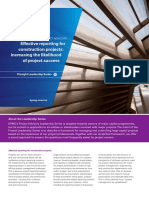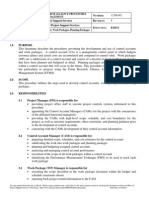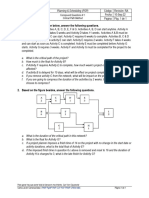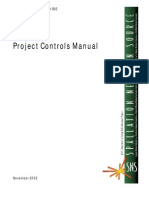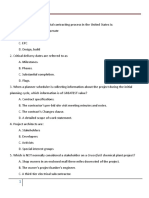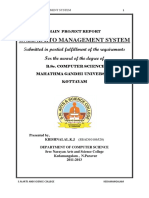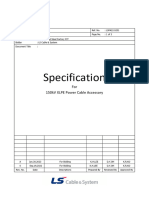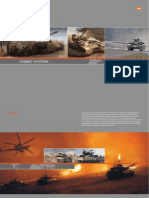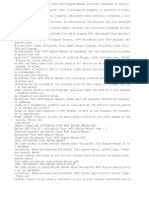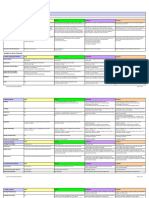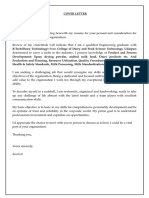Launch of the new
Introduction to Project Control
Neil Curtis APM Planning SIG APM Conference 2010
�Background
Planning SIG launched Introduction to Project Planning at APM Conference in October 2008 Discussions began in Planning SIG about follow-on projects: G id t project planning? Guide to j t l i ? Scheduling maturity model? Planning qualifications? Planning SIG members have a particular interest in project control: Because project planning and project control go together Planning defines a project, including control arrangements Difficult or impossible to control without a plan No specific APM publication about project control So perhaps a project control publication?
�What Is Project Control?
Project control is often referred to. .and it seems that it must be a project management activity activity. .but its not even defined in the 5th Edition of the APM Body of Knowledge! y g Many disciplines, processes and techniques are defined in BoK and other APM publications Project control must b i there somewhere! P j l be in h h ! But what is it?
�Thoughts About Project Control
Projects are unique, transient, risky and unstable: Project plans are imperfect and projects deviate from them Problems arise and small variances can become large Project objectives are therefore threatened So project control is required: Monitoring is not enough Variances from plan must be identified and corrected U l Use closed l d loop control, b t l based on f db k d feedback Need to be proactive, not just reactive use feed forward from one project to the next Need to control all aspects of a project: Scope Quality, time and cost Risks Problems and issues etc etc. So perhaps project control involves multiple processes?
�Thoughts About Project Control (continued)
There s Theres a spectrum of project control At one end: mostly reactive, high frequency, relatively informal At the other end: more proactive proactive, lower frequency, more formal Blending from: Pure project control via p j programmes and portfolios to business level Operational via tactical to strategic i Control to management Doing the project right to doing the right project Inner loop to outer loop
More reactive More proactive Higher frequency Lower frequency
More informal
More formal
Internal to the project
External to the project
Project
Portfolio/programme
Business
Operational
Tactical
Strategic
Control processes
Management processes
Doing the project right
Doing the right project
Inner loop processes
Outer loop processes
�Inner Loop & Outer Loop Control
Inner loop control: mostly within the project, by the project team, depending of life cycle p p g y phase Outer loop control: around multiple projects, involving stakeholders outside the project team, throughout the project life cycle
�What Are The Project Control Processes?
Introduction to Project Control identifies ten control processes In approximate innermost to outermost order: Inner loop processes: Performance Management Risk Management Issue Management Review e e Change Management Outer loop processes: Quality Assurance Life Cycle Management Continuous Improvement Portfolio/Programme o t o o/ og a e Management Governance of Project Management g
�Notes
Control of quality time and cost linked together as Performance quality, Management: Earned Value Management is a powerful Performance Management technique Quality Management is decomposed into its constituent processes: Quality Planning is part of project planning Quality Control classified as an inner loop control process Quality Assurance and Continuous Improvement are classified y as outer loop control processes The following are much more than control processes: Portfolio Management Programme Management Governance of Project Management (Identified as outer loop processes in order to address their contributions to project control) Other project management processes are non control and/or non-control doing the work
�Hence the Introduction to Project Control:
Contributors: Ken Sheard (Planning SIG chair), Neil Curtis (lead author), Jenn Browne, Andrew Chillingsworth, Martin Eveleigh, Guy Hindley, Allan Jones, Mike Semmons, Simon Springate, Thanos Tsourapsas and Paul Wasket Integrating control related topics from Body of Knowledge 5th Edition and control-related other APM publications: New context for established processes Some refinements (e.g. project life cycle) Some new material (e.g. inner & outer loop control; life cycle (e g management) Introduction-level document: Broad but not deep Referring to other APM p g publications for details Should be of interest to those new to project management Hopefully of interest to planning and control practitioners and to the project management community in general An imperfect first attempt at defining project control
�Scope and Contents
What is project control? Spectrum of control Inner & outer loop processes Why control? To maximise chances of project success When to control? Th Throughout the project life cycle h t th j t lif l Who controls? The roles of project stakeholders How to control? Description of the control processes Significance of the project management plan g project control Characteristics of good p j
�Characteristics of Good Control
Should look to the past: To immediate past performance to identify and correct variances To previous projects to avoid the same mistakes Should look to the future: Trends, forecasts, estimates at completion; risk management Aim to avoid problems rather than fire fighting Is more than just monitoring: Monitoring alone wont correct variances Effective action must be taken closed loop control Is dependent on an appropriate organisational culture: Challenging but supportive g g pp Effective sponsorship Depends on an organisational infrastructure: Obtained through experience and investment A vital asset to organisations performing projects
�Definitions of Project Control
Narrow definition: The application of processes to measure project performance against the project plan, to enable variances t b id tifi d and corrected, so th t i to be identified d t d that project objectives are achieved. Wider definition: The application of project programme and portfolio The project, management processes within a framework of project management governance to enable an organisation to do the right p j g g projects and to do them right. Project control ensures both doing projects right and doing the right projects
�Summary
Projects need control because they are unique, transient, risky and unstable: Variances will grow if not corrected Key i t K points: Projects use a spectrum of control Project control uses multiple, inter-related processes There are inner loop and outer loop control processes Control is closed loop identify variances and act on them The project management plan is vital defines the plan and the management Project control uses processes and techniques from the whole of project management Introduction to Project Control integrates the control processes in a single APM publication
�Any Questions?


















